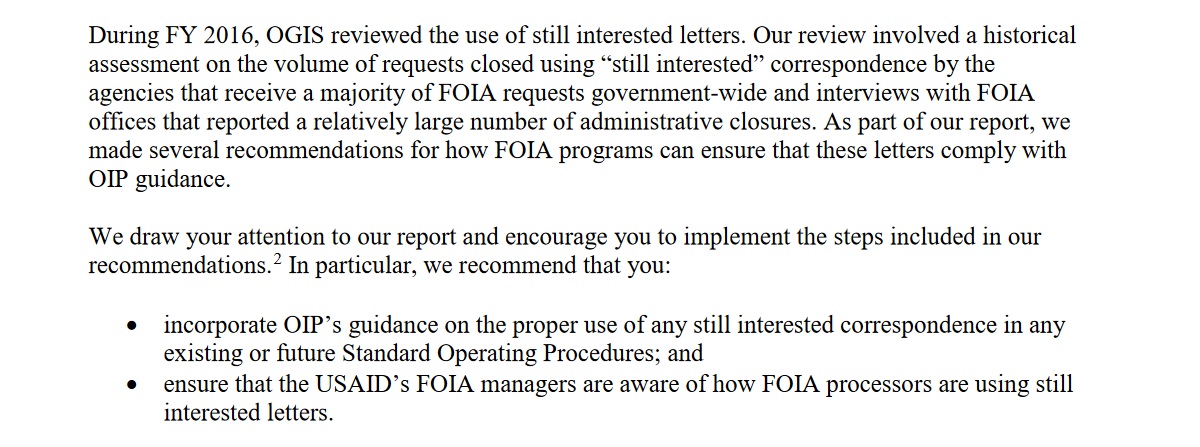Few things can be more galling for a FOIA requester than to patiently wait on a request for years, only to be told by an agency that if they don’t respond quickly and let the agency know they’re still interested, their request will be closed out.
In the worst cases, we’ve seen requesters told they only have five days to respond - and the postmark on the envelope is after the deadline, meaning only the most psychically gifted requesters even have a chance to keep their request open.
And while we’ve seen an increase in these types of letters recently, the good news is that we haven’t seen the most aggressive worst practices that we saw a few years ago.
What does a “still interested” FOIA letter look like?
Like many things in FOIA, they vary widely from agency to agency; some are very formal and come in the mail, while others are informal emails, and in other cases we’ve had agencies start with a call to the requester.
Here’s a still interested letter from the CIA we wrote about a late last year:

Here’s a recent one from US AID I recently received:
The United States Agency for International Development (USAID) regrets the delay in responding to your Freedom of Information Act (FOIA) request.
Unfortunately, USAID is experiencing a backlog of FOIA requests that has impacted our ability to process your request. Please know that USAID management is very committed to providing responses to FOIA requests and remedying the FOIA backlog.
Given the passage of time, this communication is to confirm whether you are still interested in having the attached FOIA request processed. Please confirm your continued interest, by reply to this email, within 30 working days from the date of this communication, and reference the FOIA number cited above. If we do not receive a response from you within the specified time frame, we will consider the non-response as an indication that you are no longer interested, and will close your FOIA request.
Thank you for your patience and interest in USAID.
Close readers will note that even the deadline for a response varies from agency to agency.
What are the rules around how “Still Interested” letters can be used?
After requesters (see also RCFP) and the Office of Government and Information Services raised concerns, the Department of Justice (DOJ) put together guidance on still interested letters to help at least provide some consistency and stamp out the worst abuses, such as getting deadlines that were already passed by the time the letter arrived.
But the practice of still interested letters isn’t really in the law, so it’s a bit of an improvised practice by agencies. Some don’t send them at all, and many mainly send them seasonally - towards the end of the fiscal year on September 30th, which might be why we’ve seen that uptick over the past month or so.
Shawn Musgrave requested the TSA’s policy on still interested letters, and ended up getting back some clear and succinct guidance the DOJ distributes to agencies:
Ensure there are reasonable grounds to make a “still-interested” inquiry in first instance.
Absent good cause, do not make multiple “still-interested” inquiries.
Use requester’s preferred method of communication and in the absence of a preference, communicate by telephone or email as the default.
Memorialize any decision by a requester to withdraw a request that is conveyed by telephone by sending the requester a brief email or letter noting the withdrawal.
Provide requesters no less than thirty (30) working days to respond to the “still-interested” inquiry and ensure that there is a simple way to do so.
Advise the requester that if they elect not to respond to the inquiry, the request will be administratively closed at the conclusion of the designated time period (which must be at least 30 working days).
Prior to administratively closing a request based upon the lack of a response by the requester, make good faith efforts to reach out to the requester using multiple methods of communication.
In the event a requester responds to the “still- interested” inquiry within a reasonable time after the deadline has passed, reopen the request and place it back into the processing queue where it would have been.
How should you respond to a “Still Interested” letter?
First, if you are still interested in the request, we recommend responding affirmatively quickly - sometimes processing is put on hold pending the requesters response, so following up and letting them know is a good first step.
It can also be a good opportunity to discuss why the request has taken so long in the first place - perhaps it’s a chance to negotiate parts of your request to get a quicker release. In some ways, both the requester and agency have aligned goals in this case: They want the case closed out. You can use this as an opportunity to say that you are still interested, but would be interested in discussing what they’ve done so far and possibly modifying your request to help move it forward.
You might also want to include a note stating that, going forward, the agency should assume you are still interested unless you explicitly withdraw the request.
Additionally, OGIS has continued to monitor this practice, so in addition to telling the agency you are still interested, you are encouraged to email the letter to ogis@nara.gov.

OGIS has worked with agencies to improve how they handle this process to be less frustrating with requesters (see this example from the State Department), and has been posting letters it sends to agencies about the practices.
This also gets to the heart of why these letters seem to be sent out.
At the end of each year, agencies have to put together extensive reports on how their FOIA operation is doing. Key numbers people focus on are the backlog of requests, the five oldest requests, and average response time.
Usually the hold up with very old requests is not the FOIA office itself, but the FOIA office waiting on the component that actually has the record to provide it, or approve redactions, or otherwise keep the process moving forward. If that component is not responding to the FOIA office, the records officer often sees getting the requester to withdraw the request as a next-best option for improving their overall numbers, particularly since in some cases the requester won’t still be interested in the documents.
It’s a controversial practice, however, because many requesters see the process as rewarding FOIA offices that are slow to release files. The concern goes that by letting agencies off the hook when they don’t respond to really old requests, “still interested” policies simply reward bad behavior.
Most FOIA officers I’ve spoken with said that they’re happy to keep processing requests that requesters are still interested in, but that limited resources mean triaging is the only way to keep up.
If you have strategies or questions about still interested letters you’d like to share, get in touch. I’ve reached out to a number of agencies that have been sending these kinds of letters to get their perspective as well.
Image via Medium




